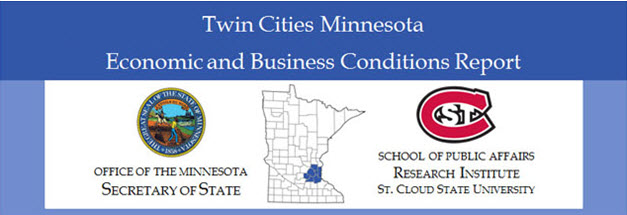Document Type
Article
Publication Date
8-2016
Abstract
A steady pace of economic growth is expected over the next several months in the Twin Cities according to the prediction of the St. Cloud State University Twin Cities Index of Leading Economic Indicators (LEI). The Twin Cities LEI was essentially unchanged in the second quarter, after rising by a revised 3.95 points in the first quarter. Three of the five index components increased in the second quarter. Lower initial claims for unemployment insurance and improvement in two general measures of statewide business conditions had a positive effect on the index, while a recent slowing of residential building permits in the Twin Cities MSA and a decline in new filings of business incorporation and LLC served as a drag on the LEI. Similar to other areas around the state and nation, the Twin Cities planning area economy is likely to grow in the coming months, albeit at a rate that is slower than normal.
There were 10,186 new business filings with the Office of the Minnesota Secretary of State in the seven-county metro area in the second quarter of 2016—representing a 1.2 percent decrease from one year ago. There were 1,489 new regional business incorporations in the second quarter, a 1 percent decrease over year ago levels. Second quarter new LLC filings fell to 6,249 in the seven-county metro area—also a 1 percent decrease compared to the second quarter of 2015. New assumed names totaled 2,034 in the second quarter. This was 1.3 percent lower than one year ago. There were 414 new filings for non-profit in the Twin Cities in the second quarter of 2016, 3.9 percent fewer filings than one year earlier.
Twin Cities employment increased by 0.8 percent over the year ending June 2016. At 3.7 percent, the planning area’s unemployment rate was slightly higher than one year earlier. Initial claims for unemployment insurance were lower than year ago levels, falling by 9.7 percent to 7,395. The average weekly wage in the Twin Cities planning area was $1,200 in the final quarter of 2015, a 4.4 percent increase over the prior year. The planning area labor force expanded by 0.9 percent over the year ending in June 2016. Annual bankruptcies continued to decline in the Twin Cities over the past twelve months. Average weekly hours and average hourly earnings were both higher in the metro area and the relative cost of living declined.
Recommended Citation
Banaian, King and MacDonald, Richard A., "Twin Cities Minnesota Economic and Business Conditions Report - Second Quarter 2016" (2016). Twin Cities Minnesota Economic and Business Conditions Report. 10.
https://repository.stcloudstate.edu/qebcr_tc_mn/10




